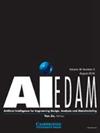冷轧模拟中预测塑性变形温度变化的降维神经网络
IF 2.3
3区 工程技术
Q3 COMPUTER SCIENCE, ARTIFICIAL INTELLIGENCE
Ai Edam-Artificial Intelligence for Engineering Design Analysis and Manufacturing
Pub Date : 2023-01-06
DOI:10.1017/S0890060422000233
引用次数: 0
摘要
冷轧过程中工件由于塑性变形而产生较大的变形,导致温度升高。这个过程是高度非线性的,需要大量的计算时间来完全模拟这个过程。本文描述了用降维神经网络(DR-NNs)来预测两段冷轧过程中塑性变形引起的温度变化。这些模型的主要目标是减少预测中的计算需求、误差和不确定性。材料特性、进料速度、板材尺寸和摩擦模型被引入作为降维的输入。不同的线性和非线性降维方法将输入空间减小到更小的主成分集合。将主成分作为神经网络的输入,用于预测输出温度的变化。将dr - nn与独立的神经网络进行比较,并在更低的计算时间和预测不确定性方面显示出改进。本文章由计算机程序翻译,如有差异,请以英文原文为准。
Neural networks with dimensionality reduction for predicting temperature change due to plastic deformation in a cold rolling simulation
Abstract Cold rolling involves large deformation of the workpiece leading to temperature increase due to plastic deformation. This process is highly nonlinear and leads to large computation times to fully model the process. This paper describes the use of dimension-reduced neural networks (DR-NNs) for predicting temperature changes due to plastic deformation in a two-stage cold rolling process. The main objective of these models is to reduce computational demand, error, and uncertainty in predictions. Material properties, feed velocity, sheet dimensions, and friction models are introduced as inputs for the dimensionality reduction. Different linear and nonlinear dimensionality reduction methods reduce the input space to a smaller set of principal components. The principal components are fed as inputs to the neural networks for predicting the output temperature change. The DR-NNs are compared against a standalone neural network and show improvements in terms of lower computational time and prediction uncertainty.
求助全文
通过发布文献求助,成功后即可免费获取论文全文。
去求助
来源期刊
CiteScore
4.40
自引率
14.30%
发文量
27
审稿时长
>12 weeks
期刊介绍:
The journal publishes original articles about significant AI theory and applications based on the most up-to-date research in all branches and phases of engineering. Suitable topics include: analysis and evaluation; selection; configuration and design; manufacturing and assembly; and concurrent engineering. Specifically, the journal is interested in the use of AI in planning, design, analysis, simulation, qualitative reasoning, spatial reasoning and graphics, manufacturing, assembly, process planning, scheduling, numerical analysis, optimization, distributed systems, multi-agent applications, cooperation, cognitive modeling, learning and creativity. AI EDAM is also interested in original, major applications of state-of-the-art knowledge-based techniques to important engineering problems.

 求助内容:
求助内容: 应助结果提醒方式:
应助结果提醒方式:


